Key takeaways:
- Reparations politics encompasses both financial compensation and the need for comprehensive solutions addressing systemic inequalities in education, healthcare, and housing.
- Local investments foster community resilience, create generational wealth, and empower marginalized communities by reallocating resources and enhancing social bonds.
- Investing locally can drive job creation and innovation, particularly in sectors like green technology and affordable housing, while improving overall community health and well-being.
- Building strong relationships with community leaders and understanding local needs are essential strategies for effective local investing, ensuring alignment with community aspirations.

Understanding reparations politics
Reparations politics is a complex and often contentious issue that delves into historical injustices and their lingering impacts on contemporary society. I remember attending a community meeting where a heated discussion erupted over whether reparations would truly benefit those in need or simply serve as a band-aid solution. It made me wonder, how do we truly measure justice in a society so deeply marred by inequality?
Understanding reparations requires us to examine not just monetary compensation but also the broader context of systemic oppression and social inequality. I often think about how a friend of mine, who has dedicated her career to advocating for marginalized communities, emphasized the need for a holistic approach. She pointed out that reparations should also address education, health care, and housing – areas where disparities have persisted over generations.
As we engage in this dialogue, it’s essential to consider who gets to define what reparations look like. During another conversation with community activists, I found myself reflecting on the emotional weight of their experiences and insights. It raised an important question for me: Are we ready to listen and learn from those directly affected by these historical injustices? Understanding reparations politics means opening our ears and hearts to the lived experiences of others.
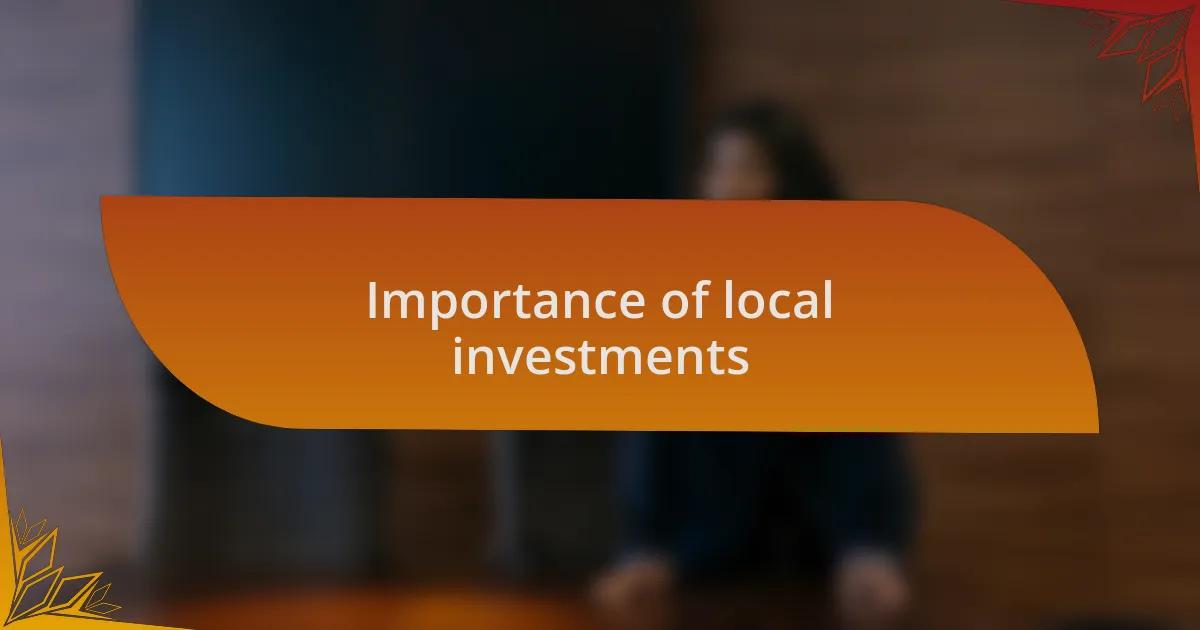
Importance of local investments
Local investments carry significant weight in shaping communities and addressing the very issues that reparations aim to confront. I recall a project in my neighborhood where a local business was revitalized through community funding. It was astonishing to see how the investment sparked new employment opportunities and fostered a sense of ownership among residents. Isn’t it fascinating how localized financial support can breathe new life into places that have often been overlooked?
Moreover, the importance of local investments lies in their ability to create generational wealth within marginalized communities. I often reflect on the stories shared by individuals who’ve benefited from programs that help local entrepreneurs. These investments don’t just provide immediate relief; they pave the way for long-term economic stability and empowerment. Could it be that anchoring wealth in the community is one of the most effective ways to combat historical inequalities?
When we talk about local investments, we are really discussing the reallocation of resources to those who have been systematically deprived of opportunities. I remember feeling inspired when I learned about a grassroots initiative that pooled funds from community members to support local farms. This not only supplied fresh produce but also cultivated a deeper connection among neighbors. Isn’t it interesting how a simple investment in local resources can ripple out to touch various aspects of our lives, reinforcing the fabric of community?
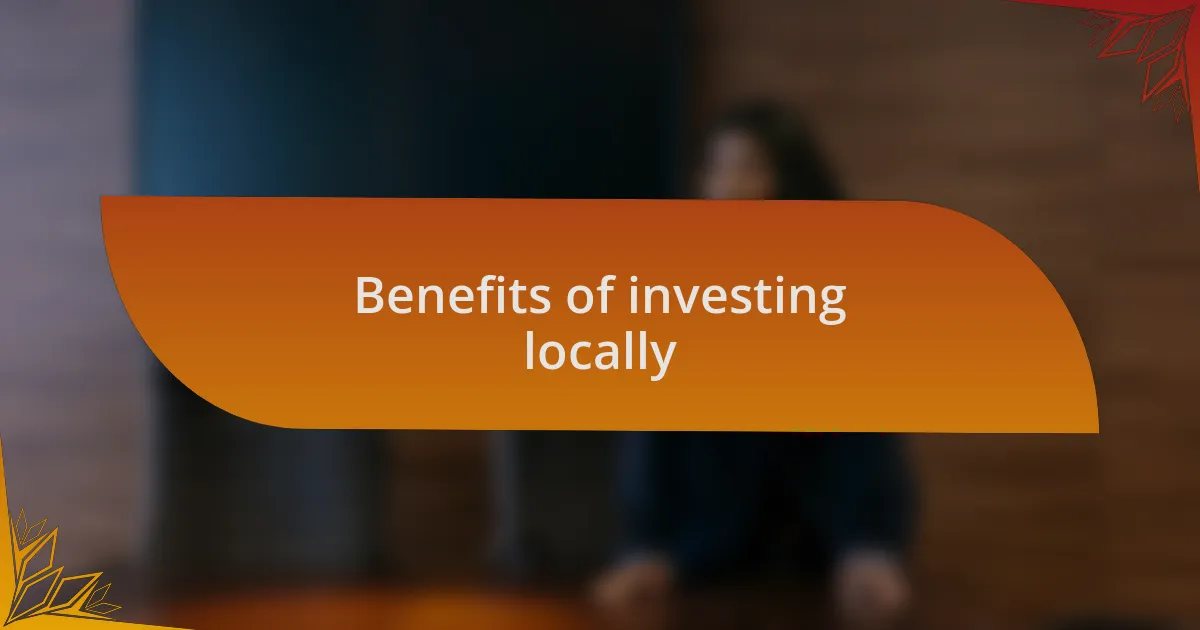
Benefits of investing locally
When it comes to investing locally, one key benefit is the immediate impact on community resilience. I remember attending a local fair where artisans showcased their handmade products. The buzz in the air was electric as people expressed pride in supporting their neighbors. It struck me just how empowering it feels to contribute to a local economy—people weren’t just buying goods; they were investing in dreams and futures right in their backyards.
Local investments also tend to bolster community bonds, fostering a stronger network of support among residents. I’ve seen firsthand how initiatives focusing on local business often lead to more interactions and collaborations between neighbors. For instance, a friend of mine started a small café that became a gathering spot for discussions and ideas. Have you ever considered how a single investment can create a hub for creativity and connection?
Additionally, investing locally can lead to more sustainable practices tailored to the needs of the community. I once visited a cooperative that prioritized eco-friendly products and services, understanding the unique challenges faced by residents. Witnessing how this commitment not only benefited the environment but also met local demands was enlightening. Isn’t it remarkable how focusing resources locally can ignite innovation and self-sufficiency?
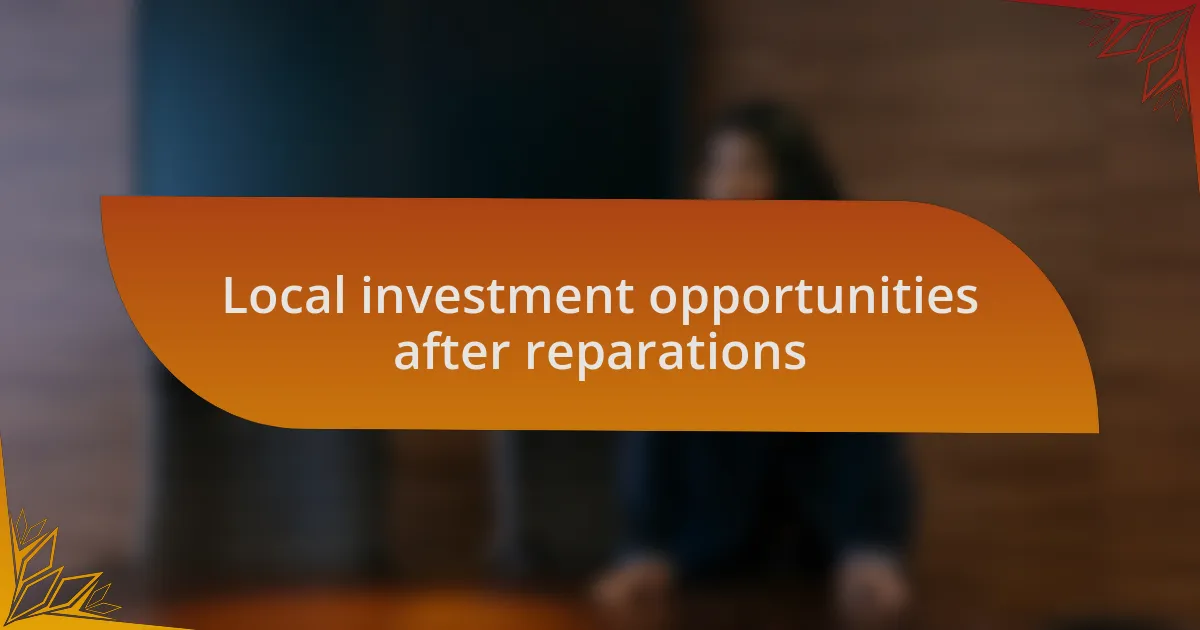
Local investment opportunities after reparations
Local investment opportunities after reparations can create a transformative landscape for communities. I remember visiting a neighborhood revitalization project where new businesses were sprouting up, largely thanks to focused financial support. The excitement was palpable; people were not just investing in businesses, but they were also fostering a shared vision for a better future. Have you ever felt the thrill of seeing a community rise together, backed by real resources?
Furthermore, these local investments often focus on sectors that directly impact the community’s quality of life. I recently met a group of entrepreneurs who banded together to open a health food store in an area traditionally underserved by grocery chains. It was inspiring to see how their dedication not only provided access to healthy options but also empowered local farmers and artisans. Isn’t it incredible to think about how local investments can improve health and well-being while simultaneously creating jobs?
Finally, the potential for job creation in the wake of reparations is substantial, especially in sectors like green technology and affordable housing. As I’ve seen through various community workshops, developing these sectors can address multiple issues simultaneously, such as sustainability, affordability, and local employment. I can’t help but ask: what if every neighborhood could benefit from such focused investment? The possibilities are endless when a community comes together to build its own future.
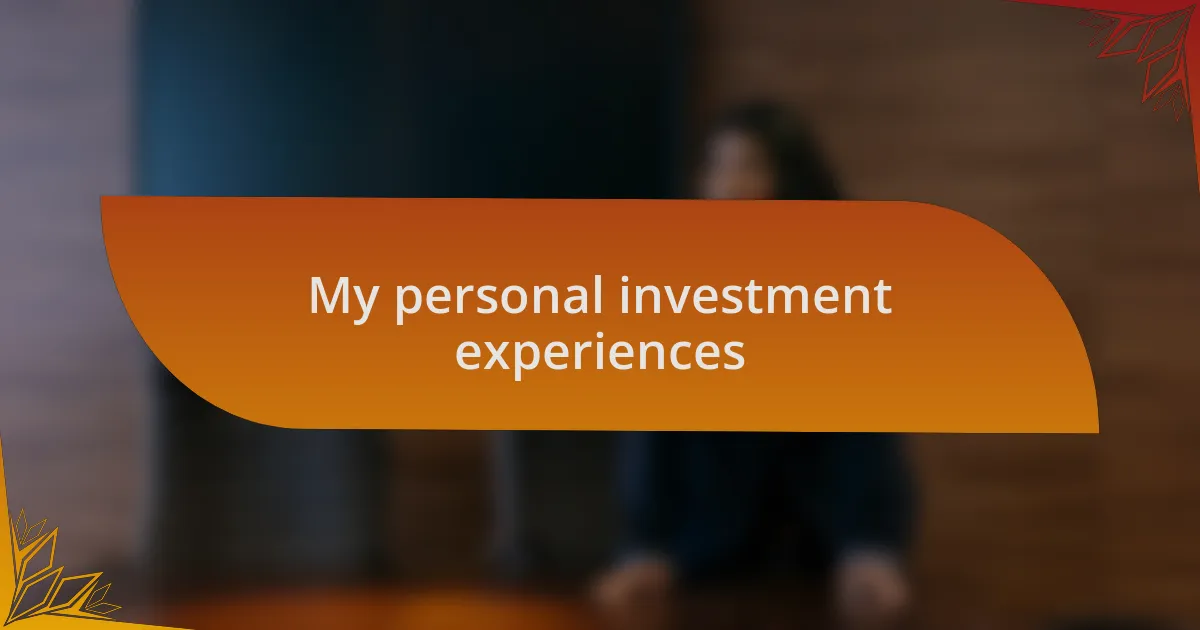
My personal investment experiences
I’ve always believed that personal investments can mirror our values and aspirations. My own journey into local investing began when I put a small amount of savings into a community-funded art project. Watching local artists thrive and engage residents deeply connected me to my neighborhood in a way I never anticipated. Have you ever felt a surge of pride in supporting something that reflects the heart of your community?
Another memorable experience was when I started to mentor a young entrepreneur who wanted to open a tech startup focused on addressing local challenges. I remember the first pitch meeting, where his passion lit up the room. His vision wasn’t just about profit; it was about creating pathways for others in the community. Isn’t it incredible how investment can ripple out, inspiring others to dream bigger and reach for more?
Lastly, I recall the bittersweet moment of investing in a local café that aimed to provide job training for youth. The initial excitement was palpable, but the challenges we faced reminded me of the intricate balance between hope and reality. Each setback taught us resilience, and I often think about how important it is to support ventures that have a social impact. Have you ever poured your heart into a project and realized that, beyond financial returns, the real reward lies in the depth of community connection?
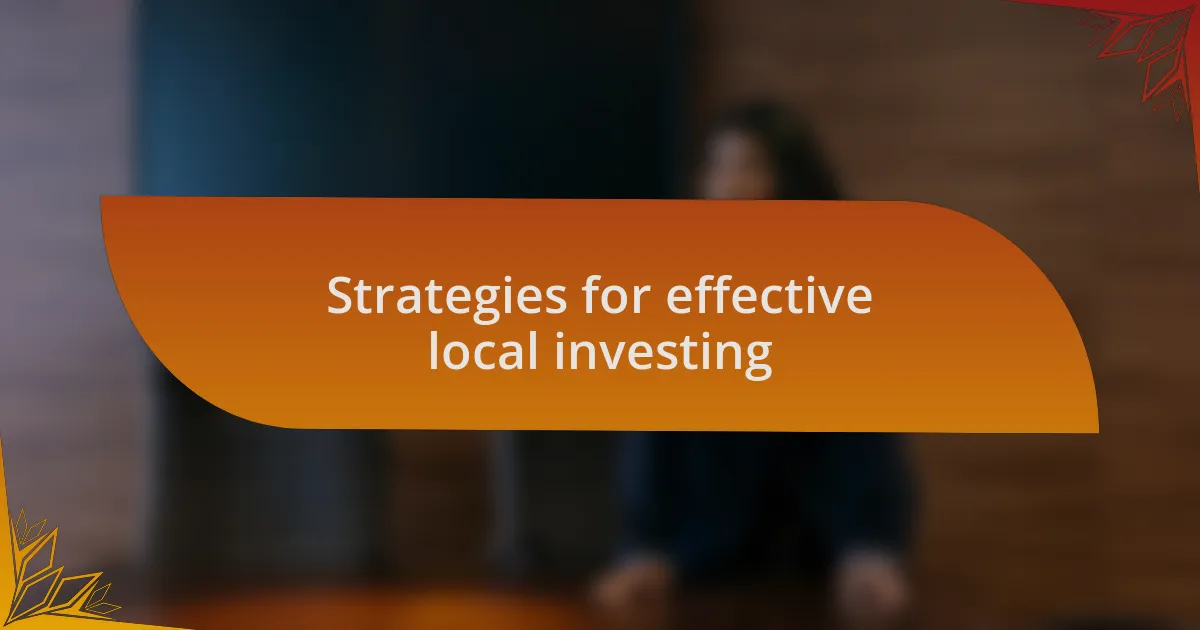
Strategies for effective local investing
When it comes to effective local investing, one strategy I’ve found invaluable is building strong relationships with community leaders. During a recent investment in a neighborhood revitalization effort, it was those connections that opened doors and provided insights I never would have gained otherwise. Have you ever considered how much easier it is to navigate challenges when you have a network of support?
Another approach I embrace is the importance of understanding the local market’s unique needs. I remember attending a town hall meeting where residents voiced their aspirations for green spaces and community programs. Engaging directly with them illuminated how my investment could align not just with profits but with their dreams. Isn’t it rewarding to realize that your financial contributions can shape the very fabric of your locality?
Moreover, I believe that diversifying investments within local spheres can lead to a more resilient community. For example, spreading my resources across various sectors like education, healthcare, and small businesses proved beneficial during economic downturns. Have you thought about how supporting multiple avenues can create a safety net for the community you care about? By aligning investments with multiple sectors, I’ve seen firsthand the way diverse support fosters overall community growth.
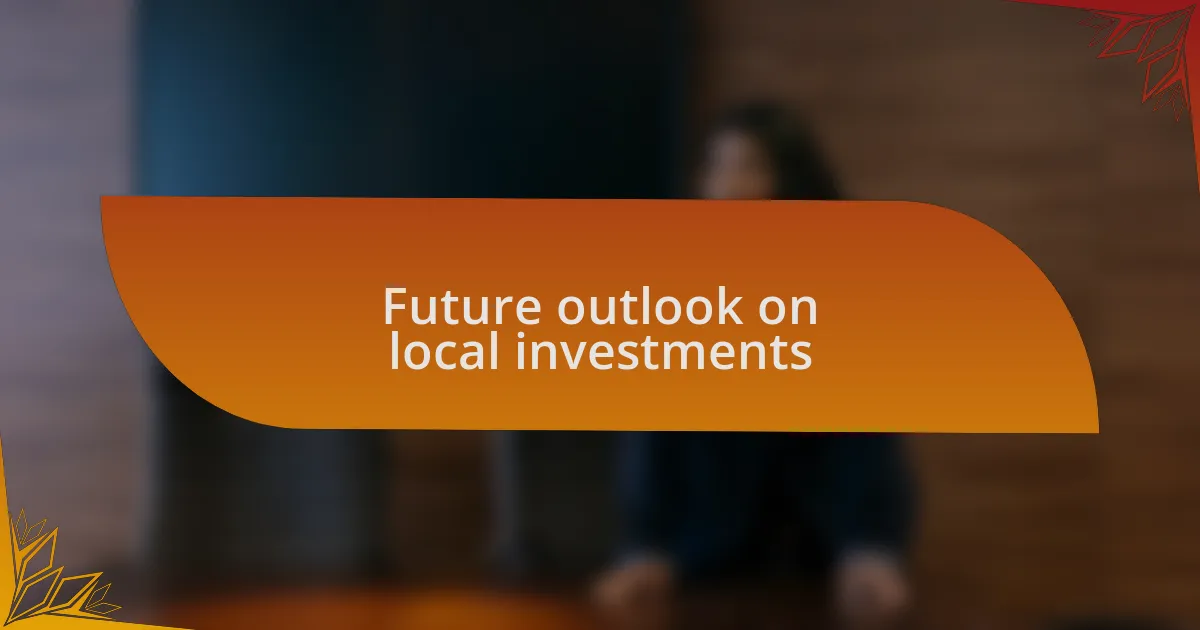
Future outlook on local investments
The future outlook on local investments is promising, particularly as communities continue to advocate for reparative measures. I recall my experience during discussions about allocating reparation funds. The palpable energy in those rooms suggested a collective determination to reshape local economies. It raises a thought: how are we prepared to capitalize on this momentum for long-term impact?
As we look ahead, I foresee an increase in investments directed toward community-driven initiatives. I remember working on a project that transformed vacant lots into community gardens, which blossomed into spaces for education and connection. Isn’t it exciting to think that such small investments can galvanize collective action and innovation?
Moreover, technological advancements are likely to play an integral role in local investment strategies. Recently, I explored a platform that connects investors directly with community projects. I can’t help but wonder: what if more of us tapped into these resources to amplify our local impact? By harnessing technology, the potential for sustainable and inclusive growth becomes not just possible, but essential.